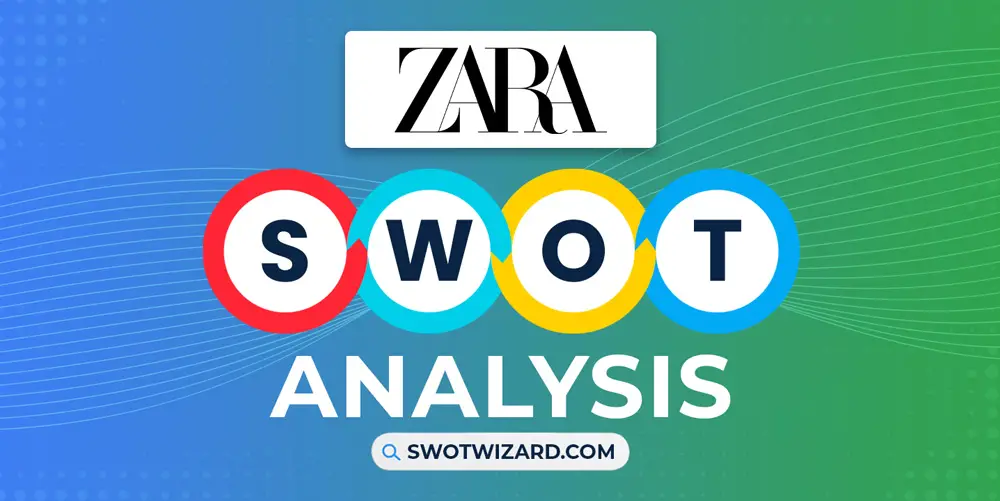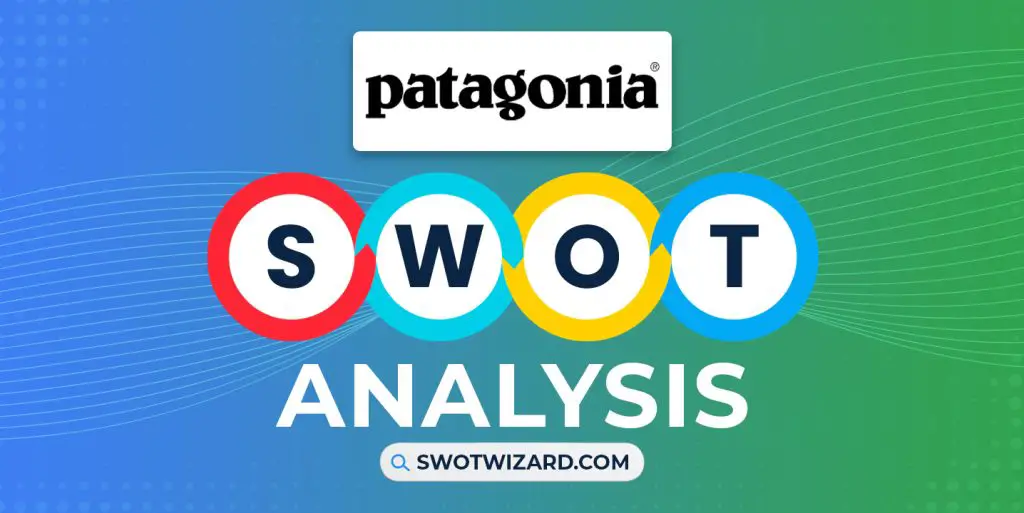Zara is a pioneer and leading name in the fast fashion worldwide. Yet even as it thrives, it’s leading a market that’s currently at threat of extinction. Let’s review how a dominant market can fail due to immoral business practices through the Zara SWOT analysis.
Zara: Company Overview
| Company | Zara |
| Industry | Fashion, Apparel |
| Founded | 1975 |
| Founders | Amancio Ortega, Rosalía Mera |
| CEO | Marta Ortega |
| Headquarter | Arteixo, Galicia, Spain |
| No. of Employees | — |
| Annual Revenue | €19,586 million (FY 2021) |
| Website | zara.com |
Zara was founded by Amancio Ortega and Rosalía Mera in 1975. The brand initially offered low-priced quality fashion collections. It was a pioneer of fast fashion, taking over Spain in 8 years and dominating US and EU markets within the next decade.
Now, Zara is a multinational fast fashion clothing chain owned by Inditex. It’s headquartered in Arteixo, Galicia, Spain. In 2023, its parent company Inditex has a market cap of $94.67 billion and generated a TTM revenue of $32.90 billion in 2022.
Product & Services of Zara
Clothing | Accessories | Shoes | Beauty Products | Perfumes
Zara Competitors
H&M | Uniqlo | Gucci | Nike | Urban Outfitters | Forever 21 | Adidas | Fashion Nova | Sephora
Did You Know?
Amancio Ortega wanted to name their business Zorba, but had to pick Zara as it was already taken.
Strengths – Zara SWOT Analysis
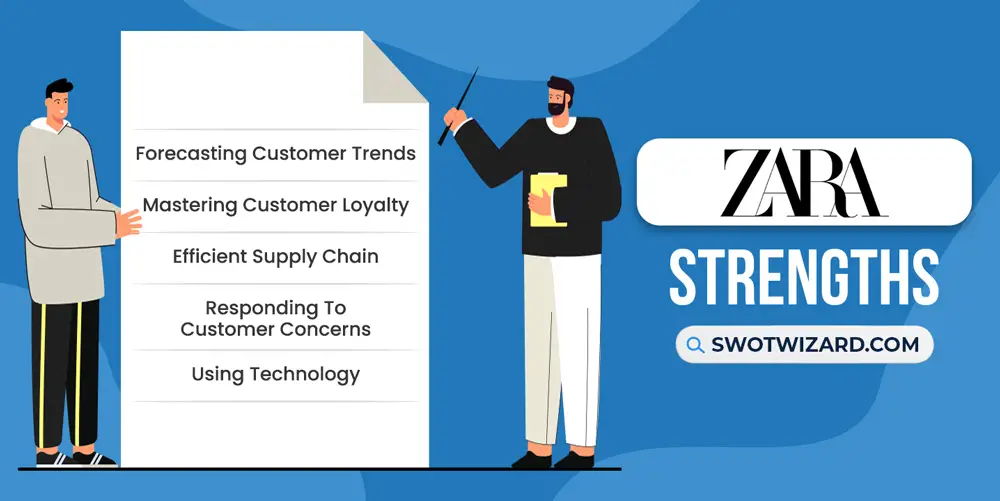
Forecasting Customer Trends: In 2020, Zara was considered to be the largest fast fashion brand, and in 2023 the company is in the 6th position. It gained its market dominance by both predicting customer trends and triggering curiosity about its product lines. Zara produces a higher number of SKUs than its competitors and tests them out, taking feedback from customers to mass-produce successful designs. Zara also pulls its customers to its product lines by aggressively engaging the customers and collecting their input, making customers feel they are contributing to the design philosophy.
Mastering Customer Loyalty: Zara focuses heavily on the customer experience, as the company relies on its image and relationship with its customer base for netting its sales. Women shop at Zara 2-3 times more frequently than they shop at traditional outlets, showing the loyalty the company’s customer base has. Zara achieves this loyalty by practicing experience, exchange, evangelism, and every place instead of the traditional 4Ps of marketing. It pulls its customers by being in every convenient space, engaging directly, providing niches, updating product lines, and creating value.
Efficient Supply Chain: Zara has created a powerful and efficient supply chain that consistently helps it push out new products rapidly and repeat its successful product lines. Zara uses vertical integration to eliminate the need for any 3rd party involvement to eliminate instability and delays in cost and resourcing. Zara reduces the bullwhip effect by manufacturing only 8,000 units of 1 design, shipping it directly from the central distribution center, and changing its collection every 2 weeks. By producing new product lines frequently and shipping directly, Zara stays on top of customer demands and becomes immune to preference shifts.
Responding To Customer Concerns: Zara doesn’t only pay attention to customer trends and demands. It also understands the value of responding to customer concerns. Fast fashion is considered a business that harms the environment, and Zara quickly promised to handle its environmental impact without losing its identity. The company promised to produce zero waste and use renewable energy, cotton, reusable packaging material, sustainable linen, and polyester while reducing its water consumption. Zara’s response to such concerns helps create a better image for its customers, and the company exploits it for higher sales.
Using Technology: Since as early as 2017, Zara has been using technology to enhance its customer experience. The company collects data on its sales, store conditions, inventory, and logistics to generate datasets that can predict ideal conditions for accelerating sales and predicting customer trends. The company can predict what items will sell more in which locations and relies on the information when stocking its outlets. Zara also uses an AI-based technology, AR, and optimizes its virtual platforms to draw in more customers and make purchasing an interesting yet simple event.
Weaknesses – Zara SWOT Analysis
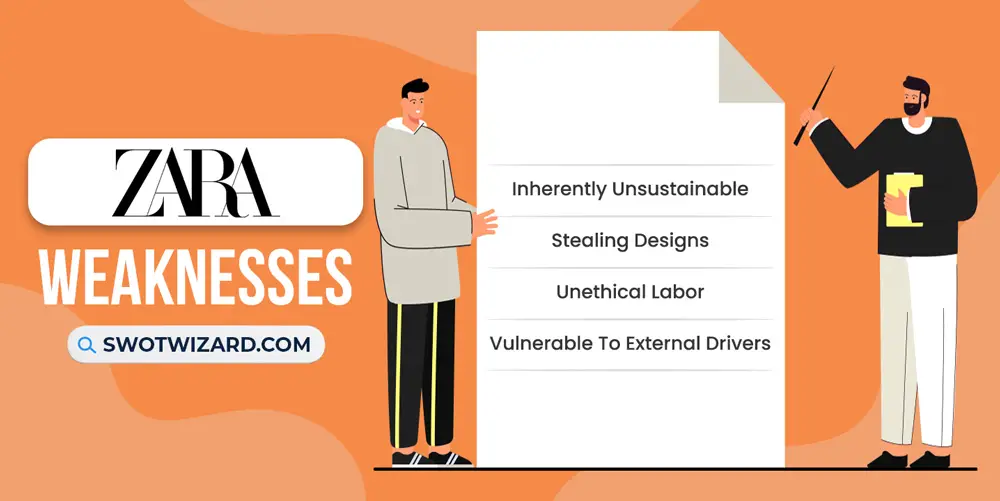
Inherently Unsustainable: Unfortunately, Zara’s goal of becoming fully sustainable is blockaded by its product philosophy. For clothing to be reusable and recyclable, it has to be of high quality, and fast fashion stands at the exact opposite of the spectrum. Wastefulness is embedded into the heart of the business, as Zara releases 500 new designs weekly and 20,000 annually, with a single factory producing 1,200 pieces of clothing a day. Zara launched its Join Life label as a sustainable product line, but it is currently only producing 35% of its entire collection, compared to the promise of full sustainability by 2023.
Stealing Designs: To create over 20,000 clothing designs and produce them annually, Zara has to create generic base designs and then rely on creating minimal alterations of base designs. However, in its attempts to do so, its design team ends up copying the artwork of other aspiring designers and artists without making any significant alterations. Zara was accused of stealing Tuesday Bassen, Adam J. Kurtz, and many other artists’ work down to the letter and selling them as its own designs. Zara contested these claims by citing the artists’ works as either generic or lacking any unique characteristics.
Unethical Labor: Zara’s fast fashion industry is fueled by international-unethical labor, and it’s an integral part of its business model. Zara has a long history of using unethical sources of labor abroad to fuel its high manufacturing needs. In 2011 and 2013, Zara was caught using illegal Bolivian and Peruvian workers working under inhumane conditions in Brazil and Argentina. The company was forced to take its sustainability claims back in 2021, as its supply chains in Xinjiang, China, and Brazil were too vital for its production, and workers there were working at subhuman standards. In 2017, Zara had put its Turkish workers under such strain that they had to sew pleas for help in clothing, demonstrating the brand’s hunger for cheap, disposable labor.
Vulnerable To External Drivers: Zara’s production and retail are easily affected by external change drivers, reducing its growth and sales within months. In 2020, the company was forced to close 3,785 stores worldwide in response to the Covid-19 outbreak, reducing its sales by 24.1%. The company lost the ability to pay its employees and resources. And it even had to hold back from paying dividends to its shareholders. Zara’s infrastructure doesn’t have any resilience to external changes, and it cannot respond to change positively.
Opportunities – Zara SWOT Analysis

Focusing On Japan And India: In 2023, shoppers in Japan and India have gone for the maximalist approach in their unique ways. Japan’s fashion trends have pivoted towards colorful and vibrant styles such as E-girl, loud prints, pop and block, and contrasting monochrome but deep styles such as gothic grunge and metallic. On the other hand, India has approached maximalism with larger sizes, color intensity, and early 90s to 2000s exaggerated styles. Both countries’ fashion choices are ideal grounds for fast fashion brands, and Zara can heavily focus on them for international revenue.
Expanding Join Life’s Collection: Zara has already dipped into sustainable clothing through its Join Life project, but the company can take it a step further. The company can offer new fabric-based products, such as wallets, handbags, and purses. It can use Jute as the material to produce these items, making the products fully biodegradable.
Moving Away To Virtual Sales: Zara can slowly close down all of its physical shops, moving its sales to its virtual platform instead. Eventually, every remaining shop can be converted into click-and-collect outlets. This decision will remove Zara’s weakness into external change drivers.
Threats – Zara SWOT Analysis
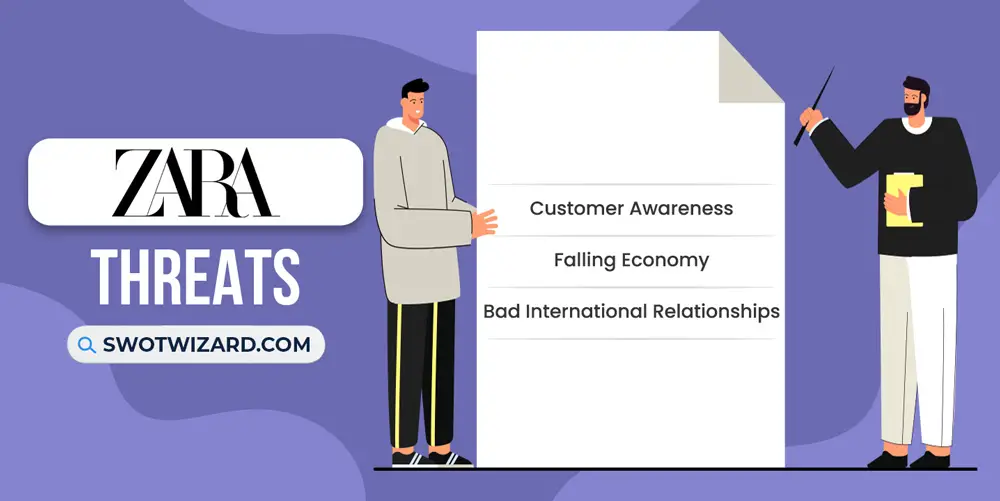
Customer Awareness: Customers have gradually become more and more aware of the adverse environmental impact fast fashion has, and moved away from it. Customers are leaning towards secondhand, quality, and vintage clothing. Zara is actively being challenged by such customers, and eventually, its business principles may be considered malicious by the majority.
Falling Economy: The customer purchasing power has been dropping lower and lower each year, limiting their ability to follow fashion trends. The average growth rate of purchasing power has come to a shocking -3.08%, with purchasing power dropping by 0.20 points from February 2023 to March 2023. The rate from last year is -5.68%, which can force customers away from Zara.
Bad International Relationships: Zara has struggled with maintaining good relations with China, as it tried to shift the blame of unethical labor on the country with its statements. The company also tried to support Hong Kong and Taiwan, which challenged the sovereignty of the nation. As China is one of its largest suppliers, it could easily go too far and get cut off permanently.
[Bonus Infographic] SWOT Analysis of Zara
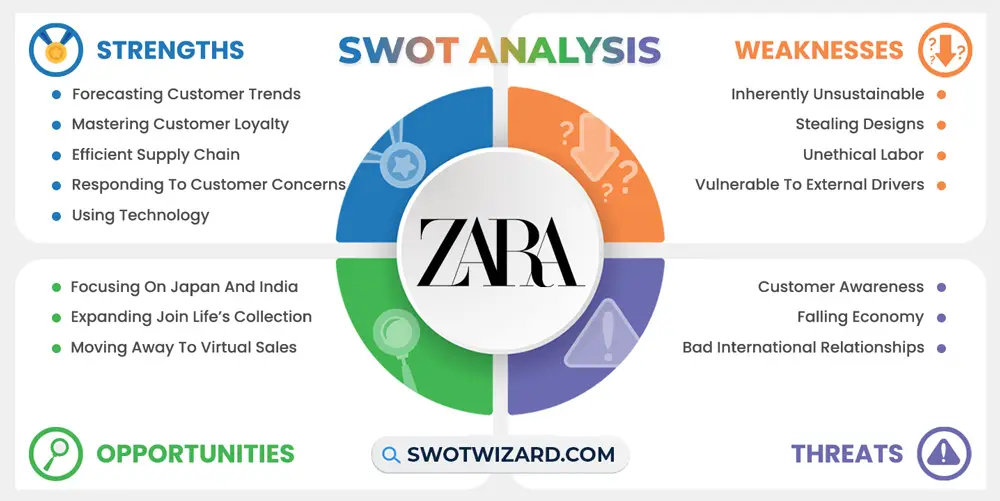
Recommendations for Zara
Zara should consider these changes if it wants to retain its customer base.
- Zara should shift away from fast fashion in US and EU markets.
- The company should implement fast fashion in Asian markets.
- It should consider producing biodegradable fabric goods.
- The company can launch a sub-label for retailing secondhand clothing.
- Zara should consider shifting production from China to India and Bangladesh to secure ethical labor.
Frequently Asked Questions (FAQs)
Who are Zara’s Ideal Customers?
Zara’s target customers are within the 18-40 age range.
Where does Zara sell the most?
Zara sells the most in Spain, where it has 256 stores.
Final Words on Zara SWOT Analysis
Zara is a market leader in a dying market that is slowly becoming demonized. To survive, it must abandon its business model and reinvent itself, focusing on sustainability and morality. Without restructuring itself, Zara is doomed to eventually become a name frowned upon by all.
References
- Wikipedia contributors. (n.d.). Zara. Wikipedia.
- Bain, M. (2021, March 25). Under pressure in China, Zara deleted a statement about Xinjiang. Quartz.
- Coronavirus impact: Zara owners shut down 4,000 stores worldwide. (2020, June 10). Business Today.
- Danziger, P. N. (2018, April 23). Why Zara Succeeds: It Focuses On Pulling People In, Not Pushing Product Out. Forbes.
- Müller, S. (2020, January 27). Zara’s fast-fashion problem in focus. dw.com.
- Dowsett, S. (2018, June 15). Zara looks to technology to keep up with faster fashion. Reuters.
- Zara’s Global Success Story: The Secret of the Leading Fashion Merchandise. (2021, May 17). Fashion Law Journal.
- Gilliland, N. (2018, April 19). How Zara is using in-store tech to improve its frustrating shopper experience. Econsultancy.
- Consumers Lead Change in Backlash Against Fast Fashion. (2019, November 25). Grady Newsource.
- Hampton, R. (2019, July 18). Zara’s New Sustainability Plan Reveals the Limits of Fast Fashion. Slate.
- History of Zara – Timeline. (n.d.). Historydraft.
- Zara: Technology and User Experience as Drivers of Business. (2017, December 15). IE Insights.
- Fast fashion at a human cost – Zara fashion retailer chooses sales over ethics. (2021, July 5). ImpACT International.
- Jordan, D. (2023, January 6). Is Zara ethical and sustainable? Wear Next.
- Kohan, S. E. (2020, March 30). Fast Fashion Leaders H&M And Zara; Weathering The Pandemic. Forbes.
- Zara Accused Of Stealing Designs From Independent Artists, And Here’s The Evidence. (n.d.). Bored Panda.
- Mavrody, N. (2013, April 3). Zara Accused of Unethical Labor Practices (Again). theFashionSpot.
- Mitsis, C. (2023, February 3). Strategy Study: How Zara’s strategy made her the queen of fast fashion. Strategy Factory by Cascade.
- Mollard, M. (2020, October 9). How Zara can stay one step ahead with trend forecasting. Heuritech.
- Mukherjee, S. (2020, November 9). How Zara became the undisputed king of fast fashion? The Strategy Story.
- Fast fashion is dead, what is the future of the industry? (n.d.). The Flash Pack.
- Zara’s Business Operations and Strategy: How and Why They Worked. (2022, September 9). ToughNickel.

